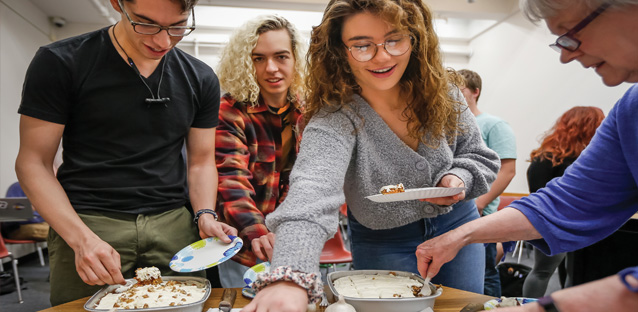"Everything is connected”: Studying English via food
Class: ENG 225: The Story of Food
Taught by: Claudia Milstead, Ph.D.
Course Description: “The Story of Food looks at various aspects of food: how food is grown, how it is prepared, how and why we eat it, and what it means to us on literal, cultural and emotional levels.”
The goal of the class: Students learn to make connections write clearly and do original research, all under the guise of learning about food.
Reading Material:Kitchen Confidential by Anthony Bourdain; Eight Flavors: The Untold Story of American Cuisine by Sarah Lohman
“Everything is connected, and it is impossible to study just one subject,” Claudia Milstead tells her English 225 class.
Today, two of those interconnected subjects include curry and soy sauce, which each occupy a chapter of Sarah Lohman’s Eight Flavors: The Untold Story of American Cuisine.
The group discussion starts with students talking about their own experiences with curry. One student says it’s her favorite. Half the students admit they’ve never tried it. Then a surprising theme emerges: the ways that racism affects how a flavor like curry migrates onto the U.S. culinary scene. For example, one of the first chefs to bring Indian cuisine to America was impacted by a 1923 Supreme Court decision that revoked citizenship rights of naturalized non-white persons.
It’s a sensitive conversation for a class designed to teach research and writing skills through the topic of food. Milstead, a professor who came out of retirement because she missed the classroom, doesn’t flinch. She’s direct, with a knack for keeping the discussion moving. She walks among the diverse group of students, asking questions and inviting opinions about what makes a food “American.”
“When you live somewhere,” one student says, “you think about that place as being about you.”
But the students recognize that the world does not, in fact, revolve around them, and they appear comfortable working through the tension of how food and racism intersect. They face questions of cultural appropriation versus respecting and celebrating other cultures. They consider Milstead’s assertion that when one group of people oppresses another, they often choose to ridicule that culture’s food. And they wrestle with the ways we choose to label food.
“The more I think about it, no food is inherently American or not American,” one student says.
The conversation is lively, and by the end of class, everyone is still laughing at Milstead’s dry jokes. They’re munching on the black pepper-and-brown sugar cookies she made them from a recipe in Lohman’s book. By the end of the semester, they’ll be presenting their own original research about an interconnected, food-related question of their choice — maybe something to do with food and racism, or marketing, or travel, or prison meals. No matter the topic, they appear ready to make the connections Milstead tells them are always possible.
–Rebecca Dell


